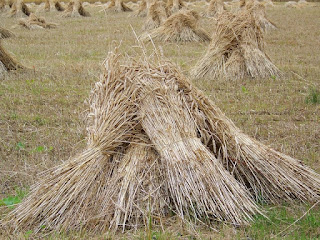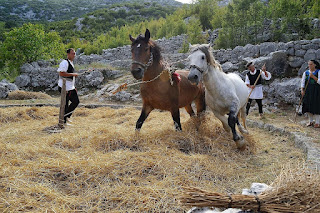A pottery cup, Syria, dated to 1800-1600 BC. The rounded body tapering to a flat base, with 26 bird heads. Christies auction...
Doves??? Similar objects were interpreted as votive objects dedicated to Ishtar/Inanna, whose sacred bird was dove...
And Demeter...
I explained why dove was sacred to Demeter in my post "Demeter with dove"...
Demeter was the goddess of grain (harvest)...And European doves nesting season overlaps with the grain harvest season in Europe...So...
Interestingly, Inanna/Ishtar, was in "A song of Inanna and Dumuzid" described as: "Maiden, glossy mane, lovely beauty...colourful as a pile of grain, fit for the king, fit for Dumuzid! Maiden...a stack of...barley, fully developed in loveliness"...
I talked about this in my post "Demeter riding a panther"...
Remember this thread about the grain symbol? See all these female bodies with grain symbol on their bellies?
This is Inanna/Ishtar speaking:
"...Before my lord, Dumuzi,
I poured out plants from my womb.
I placed plants before him,
I poured out plants before him.
I placed grain before him,
I poured out grain before him,
I poured out grain before my womb..."
I talked bout this in my post "Mother of grain"...The symbolic link between women and earth depicted on this Early Vinča Culture terracotta figurine from Jela, Iron Gate region of the Danube, Serbia, c. 5200 BC, H. 5.3 cm, which has a branching plant (grain?) growing out of the womb...
This is Inanna again:
...
As for me, Inanna,
Who will plow my vulva?
Who will plow my high field?
Who will plow my wet ground?
...
I talked about this in my post "Mother of grain from Yarim Tepe". Figurine of a nude woman form Yarim Tepe, 5000-4000 BC. Iraq Museum...
This is threshing floor, somewhere in Mesopotamia, recently...
This is threshing floor, in upper Mesopotamia, Arslantepe, Turkey, 4th millennium BC
If it works...🙂
From "Insights from a tribological analysis of the tribulum"...
In "Threshing floor in reality and metaphor", we can read that "The annual sacred marriage reenactment between Ea/Enki and Ishtar/Inanna was performed on a threshing floor"...
Fitting for the goddess that "pours grain out of her womb"...And is as lovely as as ripe barley...
Homer says this about Demeter, the goddess of grain harvest, and threshing floors:
"And even as the wind carries chaff about the sacred threshing-floors / of men that are winnowing, when fair-haired Demeter / amid the driving blasts of wind separates the grain from the chaff"...
Which is why Eugene Vanderpool in "ΕΠΙ ΠΡΟϒΧΟΝΤΙ ΚΟΛΩΝΩΙ: The Sacred Threshing Floor at Eleusis" proposes that threshing floors were sacred to Demeter and were in fact her temples...
I talked about this in my post "Sacred marriage on the threshing floor"...
And here I come back to doves...
The breeding season of most common Eurasian doves, collared dove (top) and turtle dove (bottom) starts in Apr and lasts until Sep. So it overlaps with the grain harvest season in Europe and Western Asia...Which is why, I think, this bird is associated with Demeter...Goddess of grain harvest...
Is this why dove was also sacred to Inanna, who is as lovely as ripe barley and who pours barley out of her womb and who marries the god of water on a threshing floor?
I think so...
To read more about ancient animal and plant calendar markers, start here…then check the rest of the blog posts related to animal calendar markers I still didn't add to this page, and finally check my twitter threads I still didn't convert to blog post...I am 9 months behind now...



































